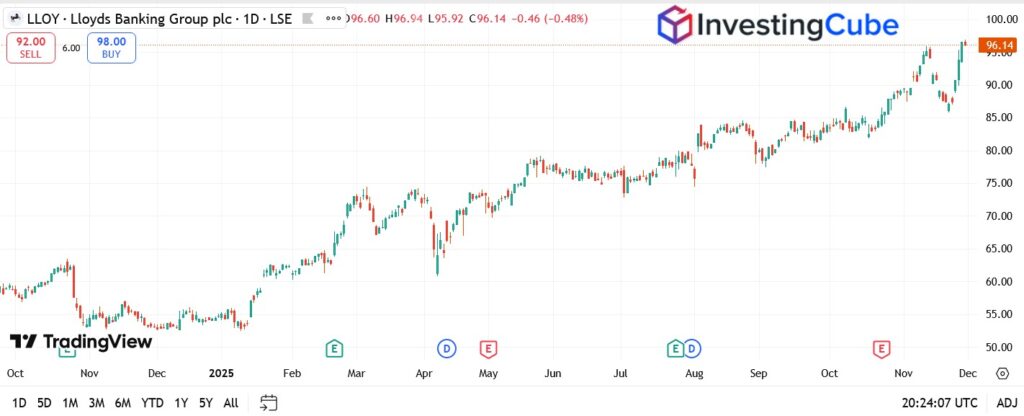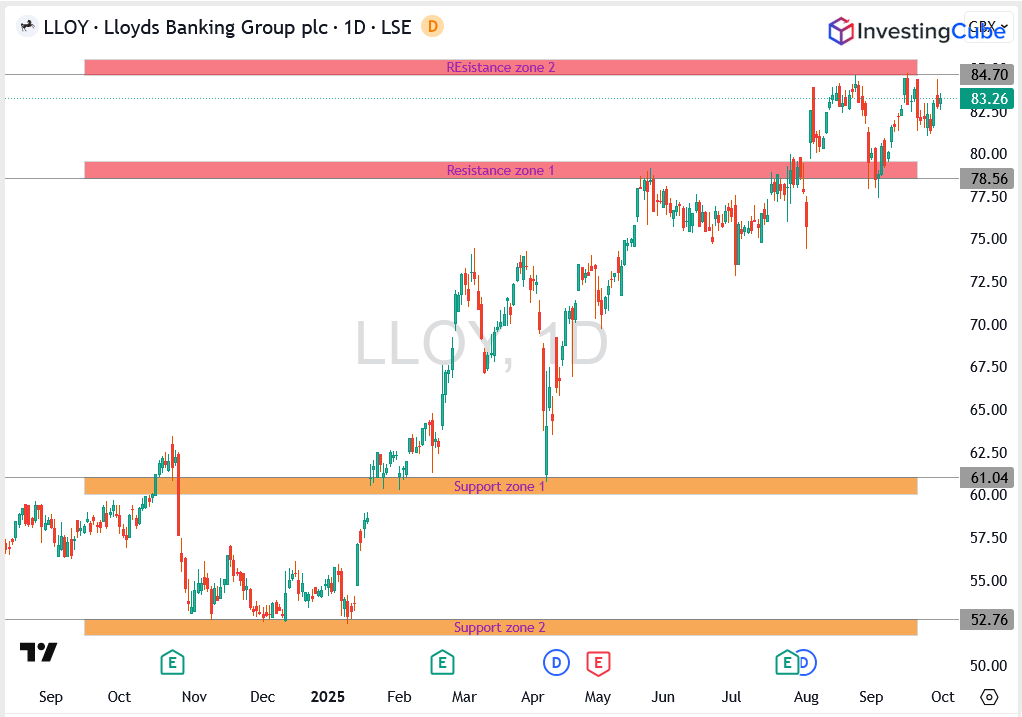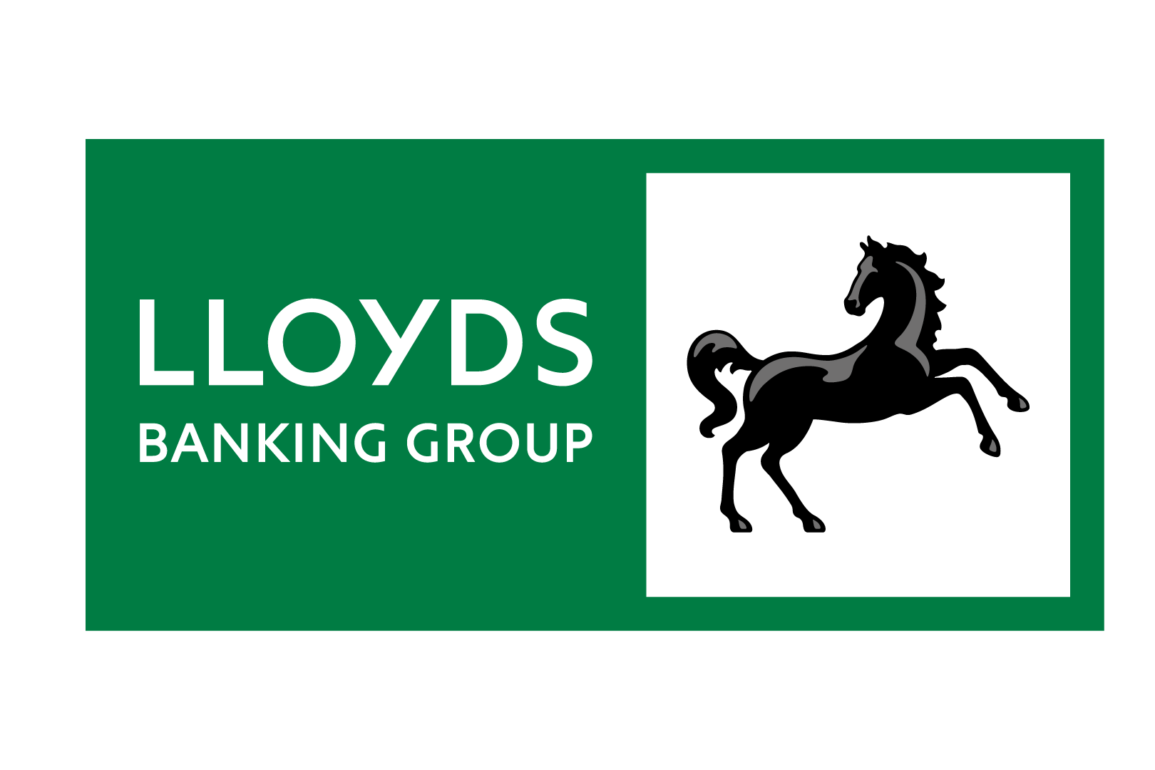- Lloyds share price climbs near 6-year highs. Chart outlook, support and resistance levels investors must watch in September 2025.
Lloyds Banking Group has extended its impressive comeback through 2025. After spending years stuck in the doldrums, the share price has now climbed to about 96p by the end of November, marking its strongest level since before the pandemic. This represents a jump of more than 70 percent from last year’s lows near 56p. The renewed momentum has firmly returned the bank to investors’ radar as one of the FTSE 100’s standout recovery stories.
So, what changed? Much of it comes down to interest margins. Higher-for-longer UK rates have fattened Lloyds’ lending book, while cost cuts have begun to filter through in earnings. “Lloyds is finally starting to look like a leaner, more profitable bank,” notes one London-based equity analyst. The market has rewarded that shift, with the share price breaking through long-held resistance around 75p earlier this summer.
But it’s not all smooth sailing. The bank is still carrying the weight of fresh provisions tied to car finance mis-selling, and the threat of windfall taxes remains a political wildcard. Investors remember how quickly sentiment turned in 2019 when regulators forced UK lenders to take billions in PPI provisions. That memory has kept a lid on overly bullish positioning, even as the technical picture has brightened.
Lloyds Share Price Outlook as the Stock Targets 100p
The chart now shows Lloyds breaking decisively above its previous resistance band, with 90p emerging as the new immediate support zone after the late November surge to around 96p. The earlier 80p floor from mid-September has shifted into a secondary support area, while the broader 85–90p region now acts as the key cushion for any pullback.
If buyers defend these levels, the stock retains room to stretch toward the psychological 100p mark. A failure to hold above 90p, however, could trigger a deeper retracement toward the mid-70s, making entry timing especially important for retail traders navigating this stronger but increasingly sensitive uptrend.

For context, Lloyds share price has outperformed its domestic peers this year. HSBC and Barclays have struggled with international exposure and litigation risks, while NatWest continues to wrestle with its restructuring story. By contrast, Lloyds’ UK-centric focus looks like a relative advantage, provided the British economy avoids a deeper downturn.
In short, Lloyds’ share price rally tells a bigger story: investors are willing to give UK banks another chance, but patience will be tested if regulation bites again or if the Bank of England pivots too quickly on rates. For now, though, Lloyds is holding onto rare momentum, something long-term holders haven’t seen in years.
This article was initially published in September 2022. and is regularly updated to reflect the latest developments in Lloyds Bank’s performance
What is Lloyds Bank?
Lloyds Bank was founded in 1765 in Birmingham. Since then, it has become a leading British company that serves more than 27 million people in the country. Lloyds has a vast network of branches across England and Wales. The bank’s subsidiary, Halifax, serves its customers in Northern Ireland, while the Scottish are served by the Bank of Scotland. Lloyd Banking Group plc is the parent of all these entities.
Lloyds Bank is considered one of the big four clearing banks in the UK. The bank’s 320-year-old history makes it one of the most credible banking institutions in the UK. Lloyds Banking Group plc currently has more than 65,000 employees. Nevertheless, due to less demand for physical branches, the bank will be shutting down some of its branches in the UK over the next few months.
Lloyds Banking Group companies offer different solutions. For example, Embark offers retirement solutions to more than 350k people with over 37 billion pounds in assets. Schroders Personal Wealth is its joint venture with Schroders, a company with over 650 billion worth of assets. Black Horse and LEX Autolease provide auto leasing solutions.
Still, Lloyds Bank makes most of its money from its banking services in the UK. Unlike its peers like Barclays and HSBC, it does not have any major footprint abroad. Following is the monthly chart of LON: LLOY listed on the London Stock Exchange.
Lloyds share price history
Lloyds Bank Group has had a long and challenging period as a publicly traded company in the UK. The firm went public in 1998. At the time, the stock was trading 130p. Shortly afterward, the stock surged to an all-time high of 548p during the dot com boom. The good times ended when the dot com bubble burst, and the shares plunged by 72% between 1999 and 2002.
During the global financial crisis of 2008, Lloyds share price took a massive hit. In fact, Lloyds Banking Group was on the verge of bankruptcy but got bailed out by the UK government. The bank received a bailout package of £20.3 billion. Nevertheless, LON: LOY hit its all-time low value of $16.38 in 2009.
Since then, Lloyd shares have been showing a sideways price action. In 2015, Lloyd stock reached the 89p level. However, the price retraced immediately and has been in a downtrend since then. The price retested a 2014 low of 23p in 2020 and got a strong rebound. The 23p region has become strong support as the price has got multiple bounces from this level.
UK banks were thriving in the high interest rates until the failure of multiple regional banks in the US sounded the alarms across the Atlantic. Consequently, investor faith in the banking industry has hit a new low as the banks report a significant decline in deposits during Q1 2023.
Lloyds Financial To Stay Strong In Near-Term
Lloyds has almost doubled its profits since the rates started to increase. In 2023, the bank’s profit is expected to remain strong. However, in the longer term, the current high-profit numbers might not be sustainable. This is bound to change as the interest rate start coming down next year.
More recently, Lloyds Banking Group plc has released the full results for 2022. The results show an increase of £2.6 billion in underwriting profit. However, due to events like the Ukraine war and Hurricane Ian, the bank had to bear an investment loss of £3.1 billion. This resulted in a pre-tax loss of £800 million.
Another factor contributing to the ongoing downtrend in Lloyds share price is the troubles at Credit Suisse. The Swiss lender is in the news once again amid rumors of getting denied funding from its top investor Saudi National Bank (SNB). Although SNB cited restrictions for its inability to increase its stake in Credit Suisse, the media report suggested otherwise. This led to a massive sell-off in Lloyds (LON: LLOY) share price as the price dropped below 46p in March.
Lloyds Bank Share News Update 2025
Athena AI helpdesk goes live, Sep 2025
Lloyds has rolled out “Athena,” a generative AI knowledge hub for its frontline teams. The aim is simple: speed up answers, cut handling time and reduce mistakes in scripted customer responses. Staff briefings describe it as a productivity tool rather than a replacement. One internal source told us the system is already shaving minutes off complex calls, a small efficiency that adds up at scale.
£10m stake in identity tech (Yoti), announced earlier in 2025
The bank quietly boosted its investment in digital identity by backing Yoti to the tune of £10 million. Lloyds frames this as a defensive move: better identity tools reduce fraud risk and protect client data, which is central to rebuilding trust after a run of retail scams across the sector.
Branch closures accelerate, plans to close 136 sites by spring 2026
Lloyds confirmed a sharper plan to reduce its high-street footprint, with a programme that will see a total of 136 branches closed across Lloyds, Halifax and Bank of Scotland brands. The bank emphasises redeployment and retraining rather than outright job cuts. For customers, the message is clear: more digital-first services, fewer walk-in options, a trade-off that will keep costs down but test community bank relationships.
Real-world assets and tokenisation trials, mid-2025
Lloyds is testing blockchain tools with third-party partners to tokenise real-world assets as collateral. This isn’t a headline product yet; think of it as experimentation. The bigger point: the bank is laying the rails to handle digital asset workflows, should regulation and client demand align.
Sustainability lending push, a large social housing retrofit loan
The bank has underwritten a significant facility to fund energy-efficiency retrofits in social housing. The deal is portrayed as both strategic and reputational: it supports net-zero targets while opening a new lending corridor that fits Lloyds’ balance-sheet priorities.
Note on scam reports
There have been media mentions about customers falling victim to romance scams. We could not verify large-scale losses specifically attributed to Lloyds beyond standard fraud warnings issued by many banks. Lloyds has reiterated standard safety guidance to customers and urged caution online.
Lloyds Bank Reports Weak Financials
Lloyds has issued its half-year results through June 2025, and while there’s growth in some areas, trouble spots remain. Profit after tax came in at £1.94 billion, slightly down from the £2.01 billion reported a year earlier. The slide wasn’t dramatic, but it reflects what management calls “provision pressures and cost inflation.
Net interest income rose by about 5%, helped by wider lending margins and growth in key UK mortgage and unsecured loan books. Other income also rose, up about 6%, driven by fees, current account activity, and gains in its retail motor finance division. That side of the business is showing improvement despite headwinds. Operating costs increased roughly 4% year-on-year, citing investments in technology, inflation-linked expenses, and some severance costs in restructuring.
The biggest wrinkle came from impairment charges: bad debt provisions jumped significantly, to £442 million, up from just £122 million last year. Management attributed much of this to a few commercial exposures and fears over macroeconomic softness, rather than widespread deterioration across Lloyds’ retail book.
Also relevant: regulatory and legal costs continue to rack up. The motor finance saga still looms large; Lloyds has set aside substantial sums to address regulatory fallout and customer redress. Such provisions are weighing on headline profit even as underlying performance holds up better.
In terms of outlook, Lloyds reiterated its guidance. It expects net interest income for the full year 2025 to be solid (with current margin trends), but noted that cost discipline and provision levels will be key. Investors will be watching closely whether the bank’s expense control and credit risk assumptions can hold up if economic growth pulses are weaker than hoped.
Lloyds Share Price 2025
So far, 2025 has been a solid year for LLOY. The stock is up more than 20% YTD, supported by strong earnings, a steady UK rate environment, and broader strength in financials. But the rally has cooled lately. Traders are watching closely to see if 72p can hold, or if a deeper pullback is coming.
What’s Behind Lloyds in 2025?
- The UK economy is holding up better than expected. That’s helped loan performance and net interest margins.
- Dividends remain steady. Shareholders are still in for income, and buyback chatter hasn’t gone away.
- Mortgage activity has slowed a bit, but Lloyds is offsetting that with gains in other lending areas.
- Bank of England has paused rate hikes, and that’s a mixed bag. It helps borrowers but could tighten margins if rate cuts show up too soon.
In short, the outlook’s still decent. But investors want more than just stability, they want signs of growth, and fast.
Updated on September 21 2025
Lloyds Share Price Inches Up, Will Bulls Push Through 72.00?
Lloyds (LON: LLOY) has been one of the quiet comeback stories of 2025. The shares sank to around 56p at the end of last year, a level that felt like yet another reminder of how long the bank had been stuck in reverse. But the tide turned quickly. Through the first half of this year, buyers pushed the stock steadily higher, finally forcing a clean break above the 70p barrier in June. That move mattered, it was the first time since 2019 that Lloyds had managed to punch through that ceiling with real conviction, giving long-suffering investors a reason to believe the recovery might stick.
Lloyds Share Price Chart Analysis
The daily chart shows Lloyds trending higher through much of 2025, lifting off the 61p support and now consolidating just under the 85p ceiling. The tape reflects steady demand, with shallow pullbacks repeatedly attracting buyers.
- Support zone: 78.50p – 80.00p. Holding above here keeps the bullish structure intact.
- Resistance zone: 84.50p – 85.00p. A daily close above 85p would open the way for higher projections.
- Stretch target: 90p – a possible upside roadmap if momentum holds into October.
Tactically, dips into the 78.50/80p range that find buyers should be seen as value zones. Failure to break 85p with conviction, however, would likely cap near-term gains and invite consolidation.
Positioning and flows: Buyers of weakness have been rewarded, with volume supporting the upside. Market behaviour remains typical of trend phases, constructive rather than disorderly.
Until we see broad distribution patterns or weak closes below support, the bias remains skewed toward higher prices.

Outlook for Lloyds Share Price in 2026
For investors, the message heading into 2026 is straightforward: Lloyds is no longer trading in the deep-value zone, but its bullish structure is still intact. As long as the 80p floor holds, the broader trend leans upward. A clean push through the 85p–90p band would signal room for another leg higher, while a sustained move back under 80p would put the rally under scrutiny. In short, the chart shows a bank stock that has rebuilt confidence but now waits for its next big driver.
Lloyds Bank Share Price Forecast 2030
To be fair, it is relatively difficult to predict where the stock will be in 2030. But looking at the monthly chart below, we see that it has been in a bearish trend in the past two decades. In this period, it moved below the descending trendline shown in black. In this period, it has crashed below all moving averages. Therefore, we can’t rule out a situation where the shares crash to about 25p by 2030.
FAQs on Lloyds Bank
Lloyds Banking Group is a British bank, headquartered in London. It is traded on the LSE and is majority-owned by investors, not the UK government.
Customers can withdraw $1000 or the equivalent in pounds, subject to daily withdrawal limits on their account or debit card. Larger sums may require advance notice at a branch.
Lloyds mainly serves UK customers, but its debit and credit cards can be used worldwide.
Yes. Most personal current and savings accounts can be opened online. New customers need to provide identity proof and address through the bank’s digital onboarding process.
This article was originally published on InvestingCube.com. Republishing without permission is prohibited.


